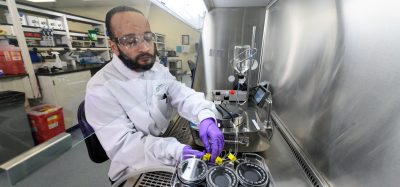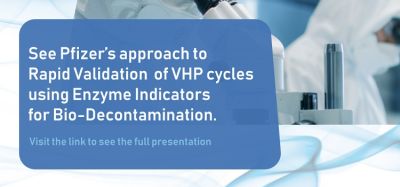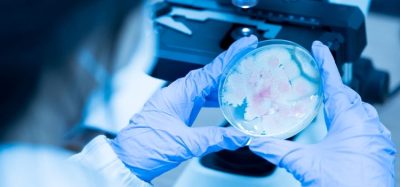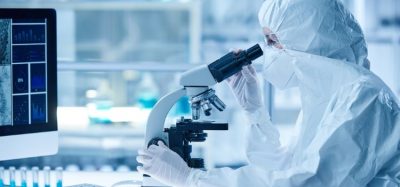Cutting edge technologies and their potential role in pharmaceutical microbiology
Posted: 23 November 2007 | Andrew M Middleton, Group Leader for New Product Development Microbiology, GlaxoSmithKline, Consumer Healthcare R&D | No comments yet
In order to meet the challenges demanded by the requirements of Process Analytical Technology (PAT), the modern microbiological laboratory needs to become more innovative in microbial detection, identification and enumeration. Technology is becoming available that will speed up microbiological analysis, potentially allowing pharmaceutical microbiology tests to get as close as is possible to the concepts of PAT. Following on from the article by Bob Johnson1, this article explores the future technologies in greater detail.
In order to meet the challenges demanded by the requirements of Process Analytical Technology (PAT), the modern microbiological laboratory needs to become more innovative in microbial detection, identification and enumeration. Technology is becoming available that will speed up microbiological analysis, potentially allowing pharmaceutical microbiology tests to get as close as is possible to the concepts of PAT. Following on from the article by Bob Johnson1, this article explores the future technologies in greater detail.
In order to meet the challenges demanded by the requirements of Process Analytical Technology (PAT), the modern microbiological laboratory needs to become more innovative in microbial detection, identification and enumeration. Technology is becoming available that will speed up microbiological analysis, potentially allowing pharmaceutical microbiology tests to get as close as is possible to the concepts of PAT. Following on from the article by Bob Johnson1, this article explores the future technologies in greater detail.
The technical requirements for any rapid microbiology method (RMM) include a combination of the following: significantly reduced time-to-result when compared with conventional microbiological methods; automated, miniaturised and high-throughput technology platforms; increased sensitivity, accuracy, precision and reproducibility; detection of a single, viable micro-organism without the requirement for cellular growth; capable of testing for total counts and specified objectionable simultaneously; enhanced detection of stressed organisms. Business requirements include: significant reduction of testing time to release products more rapidly; lower inventories (raw material, in-process material and finished product); reduction of repeat testing, deviations, OOS investigations and product rejection. Furthermore, the system should be portable and user-friendly.
Technologies at the cutting edge
While pharmaceutical microbiology has been concentrating on the regulatory requirements and validation associated with a variety of “macro” RMM systems, other industries have been forming alliances between microbiology, nanotechnology and microelectronic processing to develop the next generation of RMMs. In recent years novel microbiology systems have combined the sciences of bio-engineering, chemistry and biology, which has driven tremendous growth in the area of Bio-Microelectromechanical Systems (BioMEMS) and Nanotechnology2,3. The combination of BioMEMS and nanotechnology has made possible detection platforms on a scale similar to biological entities such as bacterial cells, viruses and spores. These “intelligent” biochips and sensors have a variety of diagnostic and therapeutic applications.
It is interesting to note that, when comparing the numbers of publications on these technological platforms, the fields of microbiology that are driving pathogen detection research over the last 20 years are the food industry (38%), water and environment (16%) and clinical diagnostics (18%)4. More recently, the bioalert sector has joined and perhaps accelerated the development of these platforms. The resulting technology potentially offers the pharmaceutical industry novel microbiology testing platforms that could be used, adapted or further developed for finish product testing, environmental monitoring and in-process controls.
While this article cannot possibly cover such a large area of research and development, it is hoped that the reader will be stimulated to explore these technologies further, with regular useful articles and updates appearing in such journals as Biotechniques, the Journal of Bioscience and Bioengineering and the Journal of Rapid Methods and Automation in Microbiology.
BioMicroElectroMechanical Systems (BioMEMS)
BioMEMS integrate a combination of mechanical, electrical, fluidic and optical elements on a common substrate, usually silicon. Microfabrication technology allows production of BioMEMS at incredibly small scales. While their use is growing the fastest in the R&D of drug discovery and delivery, many of these technologies already have, or soon will have, a place as RMMs. They can potentially be used to detect microorganisms in pharmaceutical products and to monitor air and water, with the capability of single bacterial detection5,6.
Pathogen detection is one of the most widely explored areas in BioMEMS research. A key advantge is that the technology provides equally reliable results in a fraction of time of conventional methods. In addition, the use of micro/nanoscale detection technologies has the potential advantage of providing high sensitivity by reducing the sensor sizes to the scale of the target to be detected and reducing effective reagent volumes. Furthermore, they are cost effective and have the potential to be highly portable, due to their miniaturised nature.
Biosensors
Biosensors combine a biologically sensitive element with a physical or chemical transducer to selectively and quantitatively detect the presence of, for example, micro-organisms. As with the other technologies described here, the demands for increased system portability and decreased size have driven biosensors towards micro- or even nano-scale. The concept of biosensors is not new: the use of a canary in a cage to detect lethal concentrations of gas in mines is an early example of a biosensor. Essentially the concept remains unchanged. The most widespread example of a current biosensor is the blood glucose monitor, but the technology has been developed further to detect airborne bacteria and pathogens. Detector elements work in a physicochemical manner and can include optical, electrochemical, thermometric, piezoelectric or magnetic technologies. They can be used for monitoring biological reactions at the surface of electrodes. For example; enzymes, antibodies, nucleic acids, cells and micro-organisms have been immobilised onto the surface of electrodes to develop impedimetric biosensors.
BioMEMS and mechanical transduction
Microfabricated cantilevers are one of the most widely used microstructures as mechanical sensors and they were first utilised in atomic force microscopy (AFM)7. The basic working principle of cantilever sensors is that any physical, chemical or biological stimuli can affect the mechanical characteristics of the micromechanical transducers in such a way that a resulting change can be measured using electronic (by using piezoelectric or piezoresistive materials on the surface of the cantilevers), optical (laser reflecting from the cantilever surface into a quadrature position detector, as in an AFM) or other means8. Cantilever systems have been used to detect and monitor the growth of Escherichia coli and spores of Aspergillus niger9,10 and offer a real possibility of future integration into continous, real-time environmental monitoring.
BioMEMS and optical detection
Optical biosensors work on the basis of changes in optical properties such as UV-Vis absorption, bio- and chemiluminescence, reflectance and fluorescence brought about by the interaction of the biocatalyst with the target analyte. Optical biosensors offer several advantages such as sensitivity, flexibility and resistance to electrical noise.
BioMEMS and electrical detection
Electrical or electrochemical detection strategies are commonplace in many biosensors. These techniques are more amenable to miniaturisation concepts compared to relatively bulky optical detection. Electrochemical sensors are classified into amperometric (measuring the current variation at an electrode as a result of a redox process), potentiometric (measuring the change in electric potential at the electrodes as a result of ions formed by a redox process) and conductometric (measuring conductance changes associated with variation in the medium ionicity)11. Many cellular and microbial activities involve a change in ionic species, implying an associated change in the conductivity of the reaction solution. The conductance measurements are extremely sensitive and can be used to derive information about the cause, although solution conductance may be substantially nonspecific in nature12. A single use conductivity and microbial sensor has been demonstrated by Bhatia et al (2003) to investigate the effect of concentration of metabolites of E. coli13.
Lab-on-a-chip
Microfluidics allows for the manipulation of minute amounts of liquid in miniaturised systems that are composed of a network of channels and wells that are etched onto glass or polymer chips. Pressure or voltage gradients move pico- or nanoliter volumes through the channels in a finely controlled manner that enables sample handling, mixing, dilution, electrophoresis and chromatographic separation, staining and detection. (Perhaps the most familiar everyday application of microfluidics is ink-jet printing.) Thus, microfluidics can be incorporated into “Lab-on-a-chip” platforms to produce systems or devices that can be used to perform a combination of analyses on a single miniaturised device. Analysis steps can incorporate sample preparation (including cell concentration and sorting), growth and detection, cell lysing and PCR amplification, cell growth and detection by impedance microbiology techniques.
Biochips have been developed incorporating both microfluidic principles and the concepts of BioMEMS creating micro-impedance systems. Impedance microbiology has been used for many years to monitor the cell growth and viability by measuring alternating current impedance between a pair of metallic electrodes immersed in a culture medium with microbial cells. The impedance changes because of the ionic secretions of viable cells with time. Changes also occur at the electrode–electrolyte interface. Such modifications are proportional to the concentration of viable microorganisms. Conventional measurement of impedance permits rapid detection of microbial proliferation, but approximately 1×103 – 3×107 cells/ml are required in millilitre-sized samples to produce a detectable change14. The fabrication of a microelectronic biochip for the impedance detection of micro-organisms has been shown to be capable of detecting micro-organisms within micron-sized reaction chambers15,16. The lab-on-a-chip devices consist of fluidic channels with integrated metal electrodes and can have a total fluidic path volume in the order of 30 nl. For example, the BioVitesse micro-scale impedance-based detection system concentrates the number of cells into a small incubation chamber, significantly decreasing the time to detect microbial growth, compared to currently available systems.
Quantification of bacterial cells is fundamental to many microbiological analytical requirements. There is a general interest in both the accurate enumeration of bacterial numbers and also the detection of injured or “stressed” cells. Culture-independent techniques are, therefore, important developments. Traditional culture-independent techniques include fluorescent staining and detection of bacterial cells by epifluorescence microscopy and flow cytometry17,18. Flow cytometry offers rapid, sensitive and reliable quantification of individual cells. However, traditional flow cytometry equipment is relatively expensive, and maintenance is complicated for an unskilled operator. Sakamoto et al investigated the applicability of flow cytometry within a microfluidic device and compared it to a conventional epifluorescence microscopic system for the detection of E.coli 0157:H719. The microfluidic system handled the same number of samples as the traditional system in a third of the time. In addition, the experimental technique could simultaneously measure total bacteria and specific antibody-labelled bacteria in a bacterial mixture, with no increase in test time. This illustrates the potential of such systems to deliver both a total count and absence of specified organisms in the same test. The apparatus is relatively inexpensive and does not require substantial user training or experience.
Immunological detection devices
Immunoassays have existed in various forms for many years and have been used for detection of infectious diseases, drugs, toxins and contaminants in the medical, pharmaceutical, and food industries20. The efficacy of any given immunoassay is dependent on two major factors: the efficiency of antigen-antibody complex formation and the ability to detect these complexes21. Advances in assay design have resulted in development of assays that can be performed on multiple samples simultaneously by automated systems. As improvements in detection limits have been made, through increased antibody quality and assay development, it has been possible to increase immunoassay sensitivity and specificity. Immunoassays can be performed on multiple platform types (biosensors, flow cytometry, microarray, and lateral flow diffusion devices) and there are systems available today which use different combinations of these advances. For example, the Luminex xMAP (Luminex Corp, Austin, TX) and the BV M-Series instrument (BioVeris Corp., Gaithersburg, MD) systems use basic antibody-antigen “sandwich” assay format. Both systems analyse the reactions by flow cytometry. The xMAP technology has been incorporated into continuous environmental monitoring systems22,23 and has been used for micro-organism detection24,25. The BV M-Series has been used both in the detection and identification of biothreat agents such as E. coli O157, Bacillus spores, Yersinia spp. and Salmonella enterica serovar Typhimurium26-28. The technology in both systems could potentially be adapted for pharmaceutical microbiology.
The Bio-Detector (Smiths Detection, Edgewood, MD) uses ELISA principles in a portable rugged housing. Samples are injected and separated for detection of different micro-organisms. Trapped antigen target is detected via a urease-urea reaction that causes a change in pH. The rate of the reaction is proportional to the amount of target antigen. Such “lateral flow” devices have been principally developed for rapid field assay formats, but are becoming incorporated in clinical laboratory settings giving presence/absence detection. These assays feature capture antibodies mounted on paper strips or membranes with capillary flow to move the antigen-antibody complexes in the fluid phase toward a secondary capture antispecies antibody. A positive result is obtained when the initial complex is captured with the second immobilised antispecies antibody, forming a line in the appropriate result “window”29. These lateral flow devices are commonly referred to as dipstick tests, and similar technology is found in over-the-counter pregnancy test kits. Such devices have been developed by many companies for biothreat agents, including; Bacillus anthracis, Francisella tularensis, Yersinia pestis and Clostridium botulinum. It should be acknowledged that there is little information available about their performance with respect to robustness, sensitivity and specificity, but the in-use simplicity of such tests raises intriguing possibilities for such activities such as rapid hygiene/environmental monitoring.
An adaptation of the antigen-capture principle has resulted in an interesting nanoscale detector, comprising of porous silicon that can rapidly distinguish between gram-positive and gram-negative microorganisms30. Microcavities in the silicon have been impregnated with an antibody alternative; a synthetic organic receptor specific for lipid A. Binding of gram-negative bacteria produces a photoluminescence shift. No shift is observed with gram-positive bacteria. Such a system, combined with detection platforms could offer the potential for rapid detection of gram-negatives or confirmation of their absence.
Electronic nose devices
Electronic nose devices have been used to detect the gaseous metabolic products of micro-organisms. Such technology uses transducers, such as a cantilevers, acoustic waves, or conducting polymers, coated with chemicals that reacts with specific volatile organic compounds (VOCs) or gases, to create a sensing element31. An array of sensors, each specific for different vapours or gases, can be constructed and used to detect multiple analytes. Applications of these systems have been used for detection of microbes in food32,33 and infections in humans34,35. Systems involving the detection of VOCs can be rapid and sensitive. However, they are not specific as VOCs produced by micro-organisms fluctuate with energy and/or carbon source and with environmental conditions. Despite this limitation, as a potential presence/absence test for micro-organisms, these systems may have some merit. Systems employing electrically conducting polymers may also potentially be used to detect biologically produced chemicals such as the products of microbial metabolism, for example, toxins. The polymers can be impregnated with enzymes, antibodies or other biomolecules allowing them to capture specific target biological compounds. A review by Gerard et al (2002) provides detailed information on the nature of these polymers and their potential applications in health, food, and environmental monitoring36.
Polymerase chain reaction (PCR)
An article on RMMs and cutting edge technologies would not be complete without reference to PCR. Despite the fact that PCR has existed since the 1980s and as a stand-alone technology is hardly novel, like impedance, PCR has recently been incorporated into novel platforms. Many of the lab-on-a-chip technologies use PCR to either increase detection sensitivity or provide identification of the captured target. There are also a number of tests, which have been or are in the process of being commercially developed, for rapid PCR detection and identification of microorganisms. What makes these systems advanced, compared to the myriad of PCR kits on the market, is that the systems have been designed to be operated by technicians with minimal laboratory experience; the sample processing and PCR test is automated, and the speed to result is in minutes rather than hours. Traditional PCR tests using heat blocks take hours for the amplification cycles (usually 35), due to the time required for the heat block to transition between the denaturation, annealing and elongation temperatures. The use of thermo-conductive polymers, from which the reaction tubes are fabricated, means that the PCR reaction can be heated and cooled directly by thermocouples, without the need for relatively inefficient heat-blocks, thus reducing the test time to less than an hour. Such systems were originally developed for the detection of biological warfare agents and are currently being field-tested for rapid detection of, for example, foot-and-mouth virus in animals and for near-patient testing for Chlamydia trachomatis and Neisseria gonorrhoeae in humans. These systems offer a very real potential for rapid and portable testing in environmental monitoring and in-process control.
Conclusion
In recent years, the clinical, food and bioalert industries have committed large amounts of time, effort, and funds to develop reliable platforms to rapidly detect and identify pathogenic microorganisms. Although many different detection technologies have been introduced, few of these technologies have been extensively evaluated or reviewed under “field” conditions. Many of the technologies have been tested on single organisms and/or simple sample matrices. The use of these systems on multiple “targets”, large scale sample volumes and complex sample matrices, which constitute the requirements of pharmaceutical microbiology, is yet to be proven. That said, micro-fluidic based lab-on-a-chip devices have provided important steps towards realising the single molecule/cell detection. It should also be noted that in general the volumes required to perform analysis in the micro-fluidic devices usually range from a few microlitres to hundreds of microlitres. Volumes larger than these take too long to flow and be processed and hence, appropriate macroscale sample preparation, sample cleanup and purification steps are needed to efficiently and reliably couple large samples to micro-fluidic devices. However, with the basic platforms already established, could pharmaceutical industry investment solve the outstanding limitations of the technologies presented here?
In summary, this article does not pretend to suggest that these technologies are “off-the-shelf” ready for use in pharmaceutical microbiology. However, as the next generation of rapid methods are becoming increasingly feasible the pharmaceutical industry must decide whether it wants to maintain a watching brief or take an active role in the development of these technologies to meet the demanding requirements of the pharmaceutical microbiology laboratory and manufacturing in-process monitoring.
References
- Johnson R. 2007. A “PAT” on the back for Rapid Microbiological Methods. European Pharmaceutical Review; 4: 84-88.
- Bashir R. 2004. BioMEMS: state-of-the-art in detection, opportunities and prospects. Advanced Drug Delivery Reviews; 56: 1565-1586.
- Nguyen, N.T., S.T. Wereley. 2002. Fundamentals and Applications of Microfluidics, Artech House, Boston, MA.
- Lazcka, O., F.J.D. Campo, F.X. Munoz. 2005. Pathogen detection: A perspective of traditional methods and biosensors. Biosensors and Bioelectronics; 22: 1205–1217.
- Illic, B., D. Czaplewski, M. Zalalutdinov, H.G. Craighead, P. Neuzil, C. Campaglono, C. Batt. 2001. Single cell detection with micromechanical oscillators. Journal of Vacuum Science and Technology; 19: 2825–2840.
- Karunakaran, C., D.S. Jayas. 2005. Nanotechnology – an emerging technology for use in agricultural and food research. Proceedings of the CSAE/SCGR, paper no. 05–001.
- Binnig, G., C.F. Quate, C. Gerber. 1986. Atomic force microscope. Physical Review Letters; 56, 930–933.
- Sarid, D. 1991. Scanning Force Microscopy. Oxford University Press, New York, NY, USA.
- Gfeller, K., N. Nugaeva, M. Hegner. 2005. Micromechanical oscillators as rapid biosensor for the detection of active growth of Escherichia coli. Biosensors and Bioelectronics; 21: 528–533.
- Nugaeva, N., K. Gfeller, N. Backmann, H. Lang, M. Düggelin, M. Hegner. 2005. Micromechanical cantilever array sensors for selective fungal immobilization and fast growth detection. Biosensors and Bioelectronics; 21: 849–856.
- Keller, U.E.S. 1998. Chemical Sensors and Biosensors for Medical and Biological Applications, Wiley VCH, D-69469 Weinheim, Germany.
- Tran, M.C. 1993. Biosensors, Chapman and Hall and Masson, Paris, France.
- Bhatia, R., J.W. Dilleen, A.L. Atkinson, D.M. Rawson. 2003. Combined physico-chemical and biological sensing in environmental monitoring. Biosensors and Bioelectronics; 18: 667–674.
- Felice C.J., M.E. Valentinuzzi. 1999. Medium and interface components in impedance microbiology. IEEE Transactions on Biomedical Engineering; 46: 1483–1491.
- Guan, J-G, Y-Q Miao, Q-J Zhang. 2004. Impedimetric Biosensors. Journal of Bioscience and Bioengineering; 97: 219-226.
- Gómez R., R. Bashir, A. Sarikaya, M.R. Ladisch, J. Sturgis, J.P. Robinson, T. Geng, A.K. Bhunia, H.L. Apple, S. Wereley. 2001. Microfluidic biochip for impedance spectroscopy of biological species. Biomedical Microdevices; 3 :201–209.
- Davey, H. M., D. B. Kell. 1996. Flow cytometry and cell sorting of heterogeneous microbial populations: the importance of single-cell analyses. Microbiological Reviews; 60: 641-696.
- Kepner, R. L., J. R. Pratt. 1994. Use of fluorochromes for direct enumeration of total bacteria in environmental samples: past and present. Microbiological Reviews; 58: 603-615.
- Sakamoto, C., N. Yamaguchi, M. Nasu. 2005. Rapid and Simple Quantification of Bacterial Cells by Using a Microfluidic Device. Applied and Environmental Microbiology; 71: 1117-1121.
- Lim, D.V., J.M. Simpson, E.A. Kearns, M.F. Kramer. 2005. Current and Developing Technologies for Monitoring Agents of Bioterrorism and Biowarfare. Clinical Microbiology Reviews; 15: 583-607.
- Andreotti, P.E., G.V. Ludwig, A.H. Peruski, J.J. Tuite, S.S. Morse, L.F. Peruski, Jr. 2003. Immunoassay of infectious agents. BioTechniques; 35: 850-859.
- Hindson, B. J., S. B. Brown, G. D. Marshall, M. T. McBride, A. J. Makarewicz, D. M. Gutierrez, D. K. Wolcott, T. R. Metz, R. A. Madabhushi, J. M. Dzenitis, B. Colston. 2004. Development of an automated sample preparation module for environmental monitoring of biowarfare agents. Analytical Chemsitry; 76: 3492-3497.
- McBride, M. T., S. Gammon, M. Pitesky, T. W. O’Brien, T. Smith, J. Aldrich, R. G. Langlois, B. Colston, K. S. Venkateswaran. 2003. Multiplexed liquid arrays for simultaneous detection of simulants of biological warfare agents. Analytical Chemistry. 75: 1924-1930.
- Biagini, R. E., D. L. Sammons, J. P. Smith, B. A. MacKenzie, C. A. F. Striley, V. Semenova, E. Steward-Clark, K. Stamey, A. E. Freeman, C. P. Quinn, J. E. Snawder. 2004. Comparison of a multiplexed fluorescent covalent microsphere immunoassay and an enzyme-linked immunosorbent assay for measurement of human immunoglobulin G antibodies to anthrax toxins. Clinical and Diagnostic Laboratory Immunology; 11: 50-55.
- Biagini, R. E., D. L. Sammons, J. P. Smith, E. H. Page, J. E. Snawder, C. A. F. Striley, B. A. MacKenzie. 2004. Determination of serum IgG antibodies to Bacillus anthracis protective antigen in environmental sampling workers using a fluorescent covalent microsphere immunoassay. Occupational and Environmental Medicine; 61: 703-708.
- Shelton, D.R., J.S. Karns. 2001. Quantitative detection of Escherichia coli 0157 in surface waters using immunomagnetic electrochemiluminescence. Applied and Environmental Microbiology; 67: 2908-2915.
- Yu, H. 1996. Enhancing Immunoelectrochemiluminescent (IECL) for sensitive bacterial detection. Journal of Immunological Methods; 192: 63-71.
- Yu, H., J.G.Bruno. 1996. Immunomagnetic-electrochemiluminescent detection of Escherichia coli 0157 and Salmonella typhimurium in foods and in environmental water samples. Applied and Environmental Microbiology; 62: 587-592.
- Murray, P., E. J. Baron, J. H. Jorgensen, M. A. Pfaller, R. H. Yolken (ed.). 2003. Manual of clinical microbiology, 8th ed. ASM Press, Washington, D.C.
- Chan, S., S. R. Horner, P. M. Fauchet, B. L. Miller. 2001. Identification of gram negative bacteria using nanoscale silicon microcavities. Journal of the American Chemistry Society; 123: 11797-11798.
- Deisingh, A. K., M. Thompson. 2004. Biosensors for the detection of bacteria. Canadian Journal of Microbiology; 50: 69-77.
- Keshri, G., P. Voysey, N. Magan. 2002. Early detection of spoilage moulds in bread using volatile production patterns and quantitative enzyme assays. Journal of Applied Microbiology; 92: 165-172.
- Magan, N., A. Pavlou, I. Chrysanthakis. 2001. Milk-sense: a volatile sensing system recognises spoilage bacteria and yeasts in milk. Journal Sensors and Actuator B: Chemical; 72: 28-34.
- Pavlou, A. K., N. Magan, J. M. Jones, J. Brown, P. Klatser, A. P. F. Turner. 2004. Detection of Mycobacterium tuberculosis (TB) in vitro and in situ using an electronic nose in combination with a neural network system. Biosensors and. Bioelectronics; 20: 538-544.
- Pavlou, A. K., N. Magan, C. McNulty, J. M. Jones, D. Sharp, J. Brown, A. P. F. Turner. 2002. Use of an electronic nose system for diagnoses of urinary tract infections. Biosensors and. Bioelectronics; 17: 893-899.
- Gerard, M., A. Chaubey, B. D. Malhotra. 2002. Application of conducting polymers to biosensors. Biosensors and. Bioelectronics; 17: 345-359.
Andrew M Middleton
Group Leader for New Product Development Microbiology, GlaxoSmithKline, Consumer Healthcare R&D
Andrew Middleton is Group Leader for New Product Development Microbiology, GlaxoSmithKline, Consumer Healthcare R&D. Andrew has worked for GSK for six years and heads the R&D Microbiology Group focusing in particular on in vitro modelling for product claims support and biofilm research.
Andrew has experience in rapid microbiology methods from working with rapid clinical detection systems for tuberculosis, and maintains expertise in microbial identification; specifically, Andrew is the GSK expert on genotyping, including putting forward GSK’s rationale on when and when not to use genotyping on pharmaceutical isolates.
Andrew has a PhD in Medical Microbiology from Imperial College, London, is a Charter Biologist and Scientist, and is a Fellow of the Institute of Biomedical Sciences. Andrew has a number of academic liaison roles, including a visiting lectureship at Kingston University.








